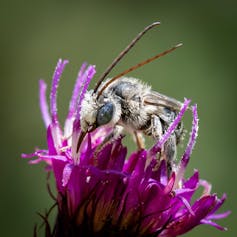With a view to reproduce, most flowering vegetation depend on animals to maneuver their pollen. In flip, pollinators depend on flowers for meals, together with each nectar and pollen. In case you’re a gardener, you would possibly need to assist this partnership by planting flowers. However in the event you reside in an space with out loads of inexperienced area, you would possibly ponder whether it’s definitely worth the effort.
I research bees and different pollinators. My new analysis exhibits that bees, specifically, don’t actually care in regards to the panorama surrounding flower gardens. They appear to zero in on the actual kinds of flowers they like, it doesn’t matter what else is round.
To design a backyard that helps the best quantity and variety of pollinators, don’t fear about what your neighbors are doing or not doing. Simply concentrate on planting totally different sorts of flowers – and many them.
Evaluating totally different landscapes
To check whether or not bees are extra plentiful in pure areas, my crew and I planted similar gardens – roughly 10 toes by 6½ toes (3 x 2 meters) – in 5 totally different landscapes round japanese Tennessee that ranged from cattle pastures and natural farms to a botanical backyard and an arboretum. All 5 gardens have been planted in March of 2019 and contained 18 species of native perennials from the mint, sunflower and pea households.
Sampling bugs in one of many take a look at gardens.
Laura Russo, CC BY-SA
Over the course of the flowering season, we surveyed pollinators by amassing the bugs that landed on the flowers, so we might depend and establish them. The sampling came about in a fastidiously standardized means. Every week we sampled each flowering plant in each backyard, in each panorama, for 5 minutes every. We used a modified, hand-held vacuum we known as the “Bug Vac” and repeated this sampling each week that flowers have been in bloom for 3 years.
We wished to check whether or not the realm instantly surrounding the gardens – the floral neighborhood – made a distinction in pollinator abundance, range and identification. So we additionally surveyed the realm across the gardens, in a radius of about 160 toes (roughly 50 meters).
To our shock, we discovered the encircling terrain had little or no affect on the abundance, range and composition of the pollinators coming to our take a look at gardens. As a substitute, they have been largely decided by the quantity and kind of flowers. In any other case, pollinators have been remarkably related in any respect websites. A sunflower in a cattle pasture had, by and enormous, the identical quantity and kinds of guests as a sunflower in a botanical backyard.
Menu planning for pollinators
We used native perennial vegetation in our research as a result of there’s proof they supply the very best diet for flower-visiting bugs. We selected from three plant households as a result of every provides totally different nourishment.
Crops within the mint household (Lamiaceae), for instance, present loads of sugary nectar and have simply accessible flowers that entice all kinds of bugs. I’d advocate together with vegetation from the mint household if you wish to present a big and various group of bugs power for flight. In case you reside in Tennessee, some examples are mountain mint, wooden mint and Cumberland rosemary. You’ll be able to simply seek for perennial vegetation native to your space.

A protracted-horned bee and an ironweed plant serving to one another out.
Ryan Sepsy
Whereas some pollinators take pleasure in nectar, others get all their fats and protein from consuming simply the pollen itself. Flowers from the sunflower household (Asteraceae), together with asters and coreopsis, supply giant portions of each pollen and nectar and still have very accessible flowers. Crops from this household are good for a variety of pollinators, together with many specialist bees, such because the blue-eyed, long-horned bee (Melissodes denticulatus), which feasts totally on ironweed (Vernonia fasciculata), additionally a member of the sunflower household.
If you wish to supply flowers which have the best protein content material to nourish the following era of robust pollinators, contemplate vegetation from the pea household (Fabaceae), akin to dwarf indigo, false indigo and bush clover. Among the vegetation on this household don’t even supply nectar as a reward. As a substitute, they supply excessive protein pollen that’s accessible solely to the best pollinators. In case you embody vegetation from the pea household in your backyard, you might observe fewer guests, however they are going to be receiving pollen with excessive protein ranges.
Deciding on a couple of native perennials from every of those three households, all extensively out there in backyard facilities, is an efficient place to start out. Simply as a range of meals is vital for human well being, a combination of flower sorts provides pollinators a different and nutritious diet. Curiously, the variety of human diets is straight linked to pollinators, as a result of many of the colour and selection in human diets comes from vegetation pollinated by bugs.
Plant it and they’re going to come
Perhaps you’ve heard that bugs worldwide are declining in quantity and selection. This challenge is of specific concern for people, who depend on bugs and different animals to pollinate meals crops. Pollinators are certainly dealing with many threats, from habitat loss to pesticide publicity.
Fortunately, gardeners can present an unbelievable service to those priceless animals simply by planting extra flowers. As our analysis exhibits, small patches of backyard can assist enhance pollinators – even when the encircling panorama has few sources for them. The one fixed in all our analysis is that bugs love flowers. The extra flowers and the extra kinds of flowers, the extra pollinators Earth could have.